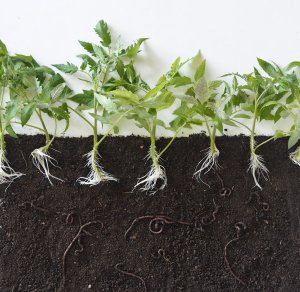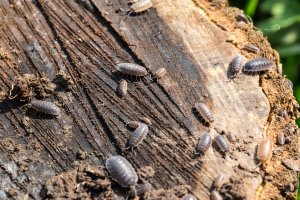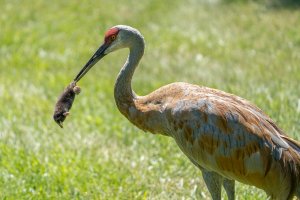Life in The Soil
May 17, 2023
By Steve Dishman, Interpreter

A lot of us tend to take dirt for granted. We may use it to plant flowers, but beneath the soil there is a whole world of activity. The main residents in the soil are a variety of invertebrates, creatures lacking a backbone or vertebrae. This group includes everything from spiders to earth worms to crayfish. Many of them have an exoskeleton, or hard skeleton or shell outside their body, to protect them from predators, drying out, or anything in their unique environment. Their legs range in number from none to hundreds!
And while the ground beneath us may seem dark and even somewhat sterile, the upper layers of the soil are an important habitat for everything from earthworms and spiders to millipedes and woodlice, commonly called pillbugs or roly-polys. But what sort of activities happen below the ground for these small invertebrates?
Size matters

First, there are many sizes of soil invertebrates. Some are called macroinvertebrates because they are relatively large. Macroinvertebrates are over 2 millimeters (mm.) long and you may have seen some of them, such as spiders, centipedes, and woodlice. The mesoinvertebrates are between .1 and 2 mm. long, and they include mites and springtails. The truly tiny microinvertebrates are under .1 mm long and are invisible to the naked human eye. All these invertebrates, no matter the size, have a role to play.
Ecological importance
Healthy soil usually has a lot of invertebrate activity in it. Many invertebrates in the soil consume dead plants, helping to move nutrients through the soil. Some invertebrates are predatory, and they consume parasitic species that could harm plants. Even the smallest invertebrates are important because they can dig to create more habitat and are vital to the diet of larger invertebrates. All this activity helps mix organic material (such as dead leaves), water from rain or snow, and air into the soil. This can help many of our plants by improving the ability of soil to hold onto water, provide nutrients to plant roots, and make spaces for those same roots to grow.
Mammals underground
Another group of animals that take advantage of the soil as a habitat are some of the small mammals. Moles, voles, shrews, and mice spend some or all of their time digging in the dirt. Moles are one of our underground superstars. They are highly adapted to life in the dark of the dirt, with large front feet and claws for digging and tiny eyes. The two species of moles here in Michigan are both insectivorous, and they love to eat the variety of invertebrates they find beneath the surface. While homeowners may not be excited to see evidence of moles tunneling in search of worms and other delicacies beneath their lawns, they are an important part of our natural ecosystems. Other mammals, such as shrews and mice, spend some time under the soil but more time right at the surface where plants, snow, and leaves give them cover. All of these small mammals, in turn, can provide an important food source for larger animals like fox, coyote, raccoon, owls, and even sandhill cranes!

Threats to soil health
Soil, like many environments, has become a victim of pollution. Natural materials are broken down by the decomposers in the soil, but synthetic, man-made products are not so easily handled. Plastics, especially, are not as easily broken down and in most cases, are harmful to invertebrates. To protect the process of decomposition, it’s a simple task for us. By recycling synthetic materials like plastics, we can reduce the probability of that material ending up in the soil. Better still, by eliminating single use plastics and using more reusable or natural materials, we can reduce the impact of pollution on that very precious habitat below your feet.
We can also consider whether non-chemical approaches might be best for maintaining our lawns and gardens. The food chain in our soil system is important for wildlife health and for maintaining clean waterways. Chemicals that are used to manage lawn grass pests (such as grubs), are consumed by many non-target species and can harm larger organisms that consume these poisoned invertebrates. Some of these same chemicals can wash off after application when it rains, entering our local streams and lakes.
Take a look beneath the soil and see what you find!
